icon
password
Multi-select
tags
ID
type
status
slug
summary
category
date
Author
URL
Not all hot pots are filled with red chili and spicy oil like Sichuan hot pot, which is a good news for people who can't eat spicy food.
When it comes to Chinese food, we never miss hot pot. When it comes to hot pot, whether foreign or Chinese diners, the first thing that comes to mind is hot pot in Sichuan or Chongqing, which is full of red soup and chilies.
There is no denying that Sichuan or Chongqing hot pot represented by spicy is the most popular hot pot in China, because of its remarkable visual and taste characteristics. But in fact, as a traditional food, hot pot has different versions in many parts of China.
Not all hot pots are filled with red chili and spicy oil like Sichuan hot pot, which is a good news for people who can’t eat spicy food.
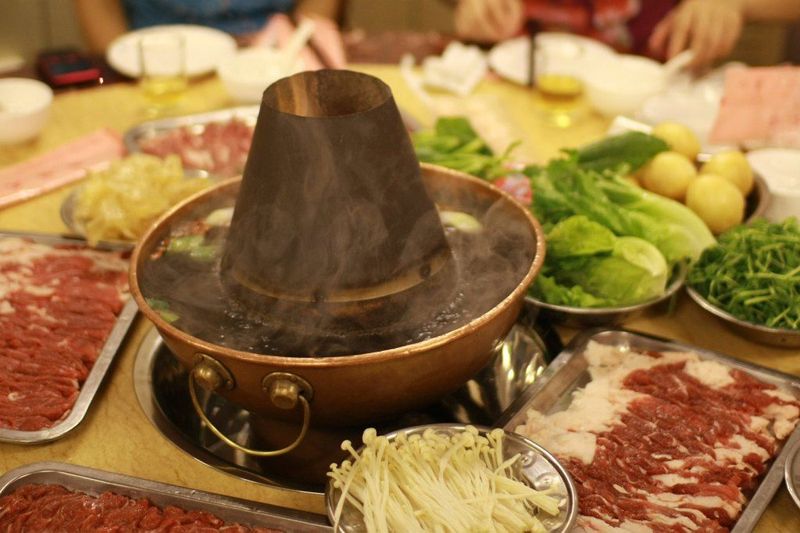
Beijing Hot-Pot
Beijing hot pot is also called old Beijing copper pot to boil mutton(老北京铜锅涮肉) or boil mutton(涮羊肉) for short. Internationally, it is also called Mongolian hot pot because they basically have the same origin and form.
If you’ve only heard of Sichuan hot pot before, Beijing hot pot will look a little incredible. Its base soup basically does not contain any seasoning, but some sliced spring onion and ginger are added to the water. The whole hot pot looks very light, and in fact it tastes so.
Beijing hot pot mainly uses mutton as an ingredient, so it is also known as instant-boiled mutton. It uses hot pot made of copper and uses charcoal as fuel. Its pot shape is very special. In fact, the “hot pot” icon used in many visual designs is Beijing hot pot rather than Chongqing hot pot.
The base soup of Beijing hot pot do not have any taste, what it shows is the delicacy of the ingredients themselves. But it offers a kind of classic sauce, which is mixed with sesame paste, vinegar, Chinese chive paste, fermented bean curd, soy sauce, minced coriander, chili oil and minced Chinese leeks.
Beijing hot pot originated in the Qing Dynasty, when the nomadic Manchu in the north became the ruling class in China, bringing Mongolian cuisine to Beijing. As a result, Beijing hot pot was originally a luxury diet of the Qing Dynasty and gradually became popular after the founding of the people’s Republic of China.
Because Beijing hot pot is so different from hot pot in other parts of China, we have written a special article to describe it: The hot pot belongs to Beijing.
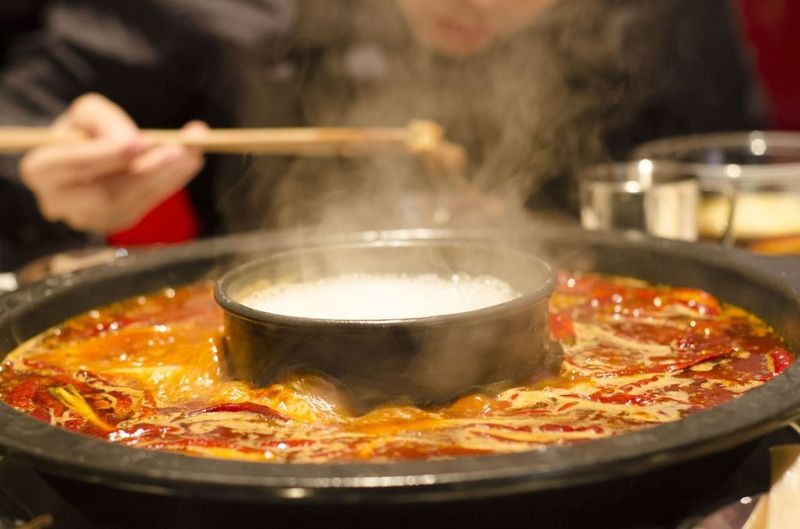
Chongqing \ Sichuan hot pot
This is the most famous hot pot, which is almost the representative of Chinese hot pot.
However, for almost all foreigners and most Chinese, it is difficult to tell the difference between Chongqing hot pot and Sichuan hot pot.
Although both hotpots are famous for their spicy flavor, in fact, the biggest difference between them is the almost completely different base soup.
Chongqing hot pot will be filled with a large amount of beaf tallow that has been pre-fried with chili peppers.
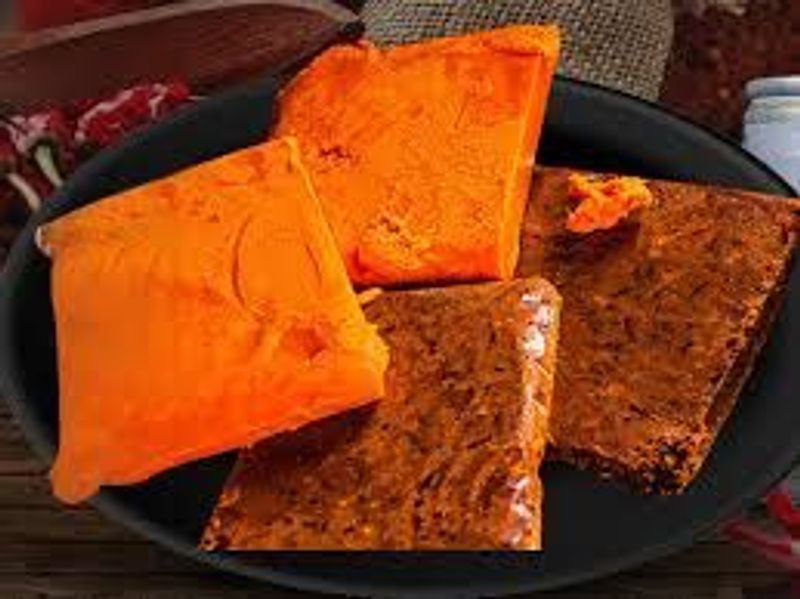
Spicy butter for Chongqing hot pot
Generally speaking, the base of a Chongqing hot pot contains 60% beaf tallow (spicy) and 40% water. In addition, ginger, garlic, Sichuan peppercorn and capsicum annuum are added, and no extra cooking oils and spices are added.
Sichuan hot pot generally does not use spicy beaf tallow, but water and rapeseed oil. Because rapeseed oil does not have the special aroma of tallow, some extra spices and chili peppers will be added.
Therefore, the spicy taste of Chongqing hot pot is mellow, while that of Sichuan hot pot is relatively dry.
In terms of ingredients, there are also some differences between the two. Chongqing hot pot is also known as “tripe hot pot”. Animal offal such as tripe, cow throat, duck blood, cow blood and so on are the main ingredients, while Sichuan hot pot has a wide range of ingredients. Beef, mutton, pork and all kinds of vegetables can be added.
Both Chongqing hot pot and Sichuan hot pot originated from the docks on the Yangtze River during the Qing Dynasty. It is said that in the Chaotianmen area, where the Yangtze River and Jialing Rivers meet, where Chinese Hui livestock were slaughtered, sailors engaged in shipping on the two rivers will wash the offal of cows and sheeps thrown away by the Hui people in the river, cut them into small pieces, and cook them in a pot to eat.
In addition, you may come across a kind of spicy hot pot called Chengdu hot pot, which is basically Sichuan hot pot, because Chengdu is the capital of Sichuan Province.
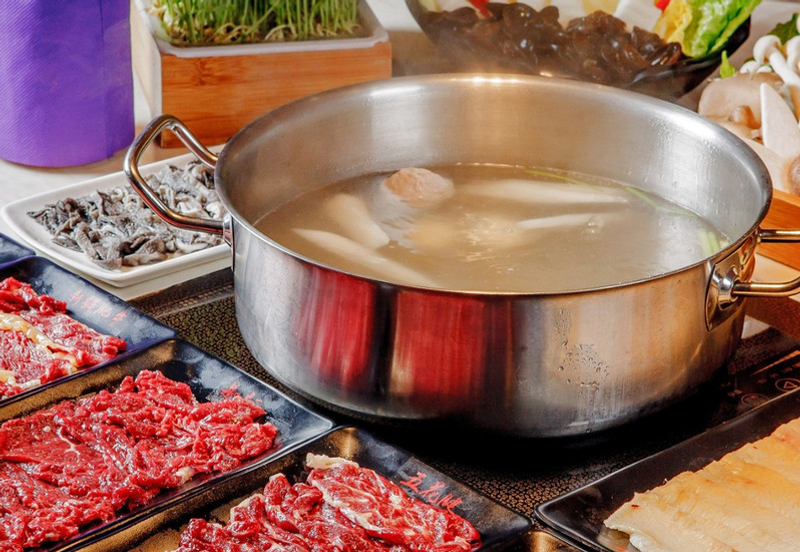
via Beef Life Hotpot
Chaoshan beef hot-pot
Chaoshan area, which is also known as Teoswa or Chiuchow in English, refers to a part of the eastern coast of Guangdong Province in China.
Compared with other hot pot, Chaoshan beef hot pot was born later. According to the data, it did not appear until the beginning of the 20th century and became popular in different parts of China after 2015.
As its name suggests, the main ingredient of this hot pot is beef, which originated in Shantou, a small city in Chaoshan region.
You are reading Panda!Yoo
A blog about modern Chinese culture and consumption trends. If you are interested in Chinese food, drinks, games, movies, novels, dramas, please follow us.
Join 1,565 other subscribers
Chaoshan beef hot pot is based on beef bone soup or water, so similar to Beijing hot pot, its base soup is very light, and the taste of the ingredients itself is its focus.
In the Chaoshan beef hot pot restaurant, meat from different parts of cow is subdivided into different dishes like steak, and the price of each is different, and the best cooking time is also different. In the process of eating Chaoshan beef hot pot, you even need to often adjust firepower to match different ingredients, which is very rare in other hot pots, so as to ensure that each ingredient is cooked to the most tender state.
Chaoshan beef hot pot restaurant also sells a by-product of hot pot-Chaoshan handmade beef balls. The parts of beef that are not suitable to be boiled will be made into this kind of meat balls. The process of making the balls requires the chef to beat the beef with a heavy gavel for more than 2 hours to ensure that the protein fibers in the beef are fully wound to form an elastic taste.
Chaoshan beef hot pot originated around 1900, and mainly used sand tea sauce(沙茶酱, Shacha sauce) with the characteristics of Chaoshan area as the base soup. But like Beijing hot pot, Chaoshan beef hot pot is a luxury dish because of its high requirements for ingredients. The development of this kind of food was interrupted by the sufferings in China’s modern history, and it was not until the economic development of China’s reform and opening up that it became popular again.
Modern Chaoshan beef hot pot no longer adds sand tea sauce to the base. Diners can choose whether they need to eat with sand tea sauce, which is more in line with the concept of healthy diet.
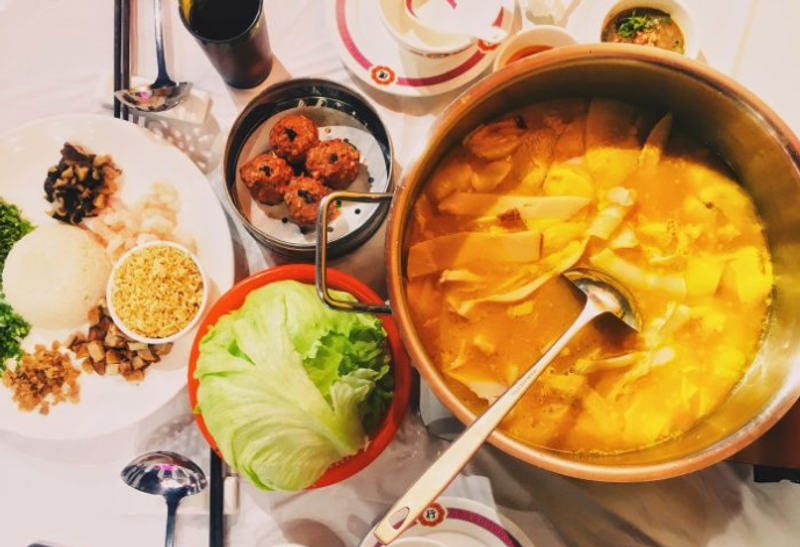
Cantonese hot pot(打边炉, beat side of furnace)
In fact, 打边炉( beat side of furnace) is the Cantonese word for “hot pot”. In Cantonese areas, “打边炉” is a general term for all kinds of hot pot. But in other areas, the word refers specifically to Cantonese-style hot pot.
Cantonese hot pot is a kind of hot pot based on seafood, and it does not contain spicy flavor. Some Cantonese-style hot pots are based on water, but most use Cantonese-style soup made from fish bones, shrimp heads and fish swim bladders. So, to some extent, even without any other ingredients, this is a pot of delicious soup.
The ingredients of Cantonese-style hot pot consists mainly of all kinds of fish balls, fish fillets, shrimp fillets, chicken, vegetables and tofu, as well as a small amount of pork, but few people add beef and mutton to Cantonese-style hot pot. Because obviously, the taste of seafood and the taste of beef and mutton do not blend perfectly.
In ancient times, Cantonese-style hot pot was eaten standing up, and the pot was a pottery pot rather than a metal pot. But now, this method is very rare.
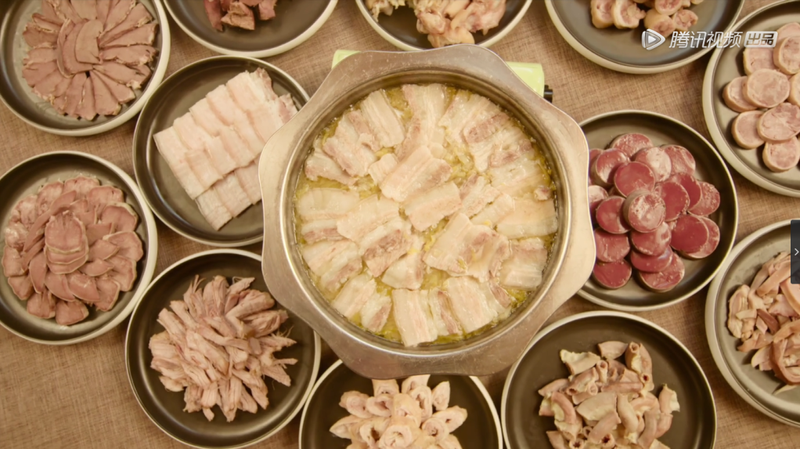
via hot pot on fire
Chinese sauerkraut white meat hot pot (酸菜白肉火锅)
Chinese sauerkraut white meat hot pot is a kind of hot pot originated from northeast China. It is a hot pot variety of northeast famous dish “stewed white meat with Chinese sauerkraut”.
Stewed white meat with sauerkraut is a Chinese dish, which is not a hot pot in itself. It is basically made from the fattest part of pork and pickled cabbage.
The northeast of China is extremely cold in winter. In the past, when there was no greenhouse technology, it was impossible for people there to get fresh vegetables in winter. In order to supplement indispensable vitamins, they have developed the custom of buying large quantities of cabbages every autumn and storing them in cellars.
In order to reduce the boredom of the taste of cabbage, some of the cabbage will be made into sauerkraut. But unlike Korea pickles or Sichuan pickles, the taste of northeast pickles is very similar to that of German sauerkraut. It does not contain any spicy taste, only a unique sour taste.
Chinese sauerkraut is not an official translation of this pickle, just because it really tastes like German sauerkraut. I call it that. It is called “酸菜” in Chinese and translated directly into English as “Sour Vegetable”.
[sociallocker id=”5614″]
Just as sauerkraut is often served with German sausages and pig feet, the sour taste of Chinese sauerkraut can just match the greasy taste of pork, which makes sauerkraut and “almost pure white” fat pork a perfect combination, and the dish “stewed white meat with Chinese sauerkraut” was created.
Chinese sauerkraut white meat hot pot basically adds a gas stove to the bottom of the dish to keep it boiling. Therefore, its base soup is sauerkraut soup mixed with fat pork. This sour soup reacts beautifully with a variety of fatty meats.
In terms of ingredients, sauerkraut white meat hot pot is limited to pork, pig offal, pig blood tofu, fish balls, tofu and various vegetables. All the ingredients will be covered with the aroma of pork, so diners who like pork will like this hot pot very much. But the price is that all the ingredients that don’t match the taste of pork will be difficult to cook.
In terms of sauce, sauerkraut white meat hot pot can be eaten with mashed garlic, and the slight spicy taste of mashed garlic can further alleviate the greasy taste of pork fat.
It is worth mentioning that outside the northeast, you can hardly eat sauerkraut white meat hot pot, but can only eat “stewed white meat with Chinese sauerkraut” instead.
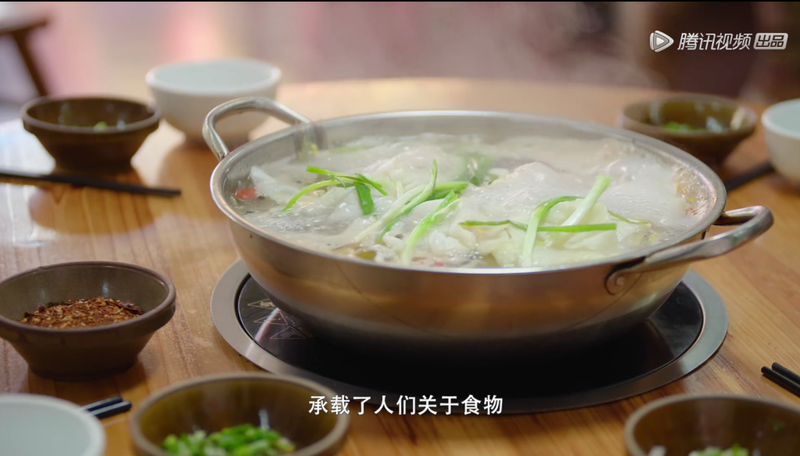
via hot pot on fire
Guizhou sour soup hot pot
The base soup of Guizhou sour soup hot pot is a liquid fermented by the water left over from cooking glutinous rice. Its sour taste is light, with the aroma of glutinous rice, very delicious.
With liquid as the basis, add shallot, ginger, garlic, Litsea and other seasonings to form the base of Guizhou sour soup hot pot.
When fish, shrimp and other ingredients are added to such sour soup, organic acids can react with these fresh meats, making their meat more fresh and tender. At the same time, the sour taste can also cover up the earthy taste brought by the river fresh, so that the overall taste can be upgraded to a higher level.
In addition to river fresh, mushrooms are also the main ingredients in Guizhou sour soup hot pot. The folds on the mushrooms absorb a lot of sour soup, making it stand out.
Guizhou sour soup hot pot is divided into two kinds, one is red pot and the other is white pot. You may mistakenly think that the white pot is not spicy, but then you are deceived. In fact, all Guizhou sour soup hotpots are filled with Guizhou special chili peppers, which are the kind of chili used by Lao Gan Ma hot sauce, so they are all spicy.
The red Guizhou sour soup hot pot uses sour soup made from tomatoes instead of glutinous rice fermentation broth as the base to suit diners who cannot accept fermented food outside Guizhou.
Guizhou sour soup hot pot originated from the Miao people who lived in Guizhou in the Ming Dynasty. The process of its invention is similar to that of yogurt, which stems from a mistake. A man made the wrong fermentation in the process of making glutinous rice wine, producing the sour liquid that forms the base of the hot pot. After trying it, it was found to significantly boost people’s appetite, so it quickly became popular among local residents.
The red Guizhou sour soup hot pot appeared relatively late, about the end of the Qing Dynasty. Because at that time, tomatoes were officially used as common ingredients in China.
These are the six common types of hot pot in China, but that is not all.
[/sociallocker]
In many parts of China, there are some distinctive but unpopular hot pot types that are worth exploring. WeTV launched a food documentary Pot of Fire, about Chinese hot pot in early 2020. If you are interested, you can try to watch it.
In addition, we have previously introduced seven kinds of Chinese food that look like hot pot but are not hot pot. These Chinese foods are more suitable for eating alone than hot pot, so if you are traveling alone, you can try them.
If you only travel to China for a short time, you may find that you don’t have time to find other hot pot restaurants besides Sichuan hotpot. In particular, the type of hot pot such as sauerkraut white meat hot pot and Guizhou sour soup hot pot is often concentrated in its place of origin. It will be very diffcult to find one when you want to look for these hot pots overseas.
In fact, Chinese hot pot chains are worth choosing (such as Haidilao, Xiabu Xiabu, Coucou). Although these hot pot chains are considered “less authentic” by Chinese diners, they often offer a variety of different pot base soup at the same time. You can even combine different flavors in a mandarin duck pot, not just spicy and non-spicy.
Of course, if your travel plan includes the origin of those hot pot, be sure to add “tasting special hot pot” to your itinerary.
- Author:NotionNext
- URL:https://pandayoo.com/2020/10/14/there-are-6-different-kinds-of-hot-pot-in-china-you-may-only-know-sichuan-hot-pot
- Copyright:All articles in this blog, except for special statements, adopt BY-NC-SA agreement. Please indicate the source!